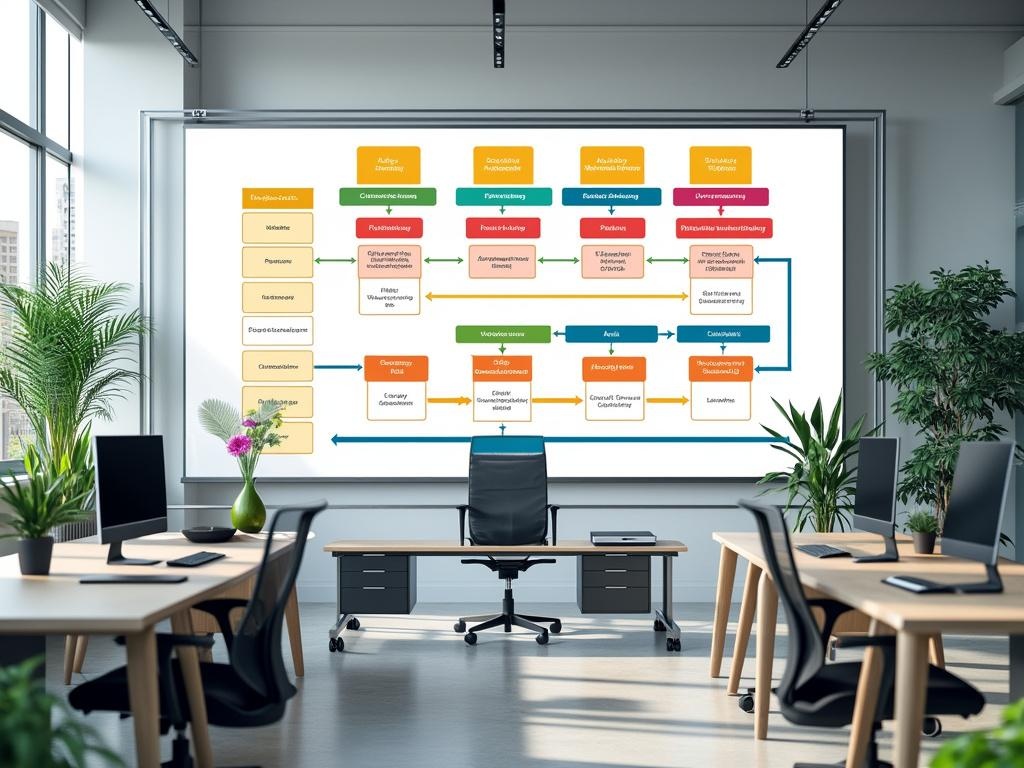
Understanding Business Development Process Maps
A business development process map visually outlines the structured framework organizations use to identify opportunities, nurture relationships, and drive growth. This strategic tool diagrams the interconnected activities, decision points, and workflows that guide business development efforts from initial prospect identification through successful partnership or sales closure.
Why Business Development Process Maps Drive Organizational Excellence
Business development process maps eliminate operational ambiguity and significantly improve cross-functional alignment in growth initiatives. By providing a clear visualization of responsibilities, handoffs, and decision criteria, these maps prevent valuable opportunities from slipping through departmental gaps while shortening sales cycles. Organizations using well-designed process maps see improved lead conversion rates, better team accountability, and more predictable revenue outcomes. This transforms your business development from random efforts into a systematic, repeatable engine for sustainable growth.
Creating an effective business development process map helps you visualize your entire growth strategy. You’ll track each step from prospect identification to deal closure with precision. The right map serves as your roadmap to success, guiding teams through the complex business development journey.
Your business development process map should include key decision points, responsible team members, and expected outcomes at each stage. This clarity helps everyone understand their role in the growth process. With a proper map in place, you’ll spot bottlenecks quickly and make adjustments to keep opportunities moving forward.
Remember that your business development process map isn’t static. It should evolve as your business grows and market conditions change. Regular reviews ensure your map continues to reflect your current business development reality.
Companies that effectively use sales process mapping are 33% more likely to achieve their revenue targets and improve overall sales effectiveness.
Creating a Business Development Process Map: Your 5-Step Guide
A business development process map serves as your organization’s visual roadmap for opportunity identification, client relationship building, and revenue growth acceleration. This strategic tool clearly outlines each critical phase in your business development cycle, from finding prospects to closing deals and maintaining valuable client relationships. Many executives find that effective process mapping transforms their approach to growth initiatives.
Your process map converts abstract business goals into concrete, actionable workflows with defined responsibilities. It helps eliminate wasteful processes, standardizes successful practices, and creates a framework for tracking important performance indicators such as conversion percentages and sales cycle speed. This visual representation acts as the foundation of your business development strategy, ensuring your teams execute consistently while maintaining enough flexibility to respond to market shifts.
With a well-designed business development process map, you’ll gain clarity on exactly how opportunities move through your pipeline, where bottlenecks typically occur, and which stages require additional resources or attention.
1. Define Your Business Development Goals
Creating an effective business development process map starts with clearly defining your objectives. Your business development process map needs specific, measurable goals that align with your company’s broader strategy. Begin by identifying the key performance indicators (KPIs) that will track progress and success in your business development efforts. These might include metrics like lead conversion rates, sales cycle length, or market penetration percentages.
When establishing your goals, ensure they follow the SMART framework—Specific, Measurable, Achievable, Relevant, and Time-bound. This approach creates clarity and focus for your entire team. Document your success criteria in detail, as these will serve as benchmarks against which you’ll measure performance.
Consider these key elements when defining your goals:
- Revenue targets by product, service, or market segment
- Customer acquisition cost thresholds
- Client retention rates
- Sales pipeline velocity metrics
- Partnership development objectives
Proper strategic planning at this stage creates the foundation for a business development process map that drives meaningful results.
2. Map Current State Processes
Creating an effective business development process map begins with a thorough understanding of your existing workflows. Schedule interviews with key stakeholders who interact with your business development processes daily. These conversations provide invaluable insights into how work actually flows through your organization, not just how it’s supposed to flow.
Document all existing workflows systematically, capturing each step in your current business development process map. Use flowcharts, diagrams, or specialized mapping software to visualize information flows, handoffs, and decision points. This documentation creates a foundation for identifying improvement opportunities.
Through stakeholder interviews and active listening, identify pain points and bottlenecks that slow down your business development efforts. Common issues include redundant approvals, communication gaps, or undefined responsibilities that create confusion. These problem areas often represent the greatest opportunities for process optimization.
Finally, gather quantitative performance metrics that illustrate how your current process performs. Track indicators such as:
- Lead conversion rates
- Average sales cycle duration
- Proposal win rates
- Customer acquisition costs
- Revenue per business development resource
These metrics establish a baseline against which you can measure process improvement success and help justify any resource investments needed to optimize your business development process map.
Expert Insight: To effectively map current state processes, engage key stakeholders through interviews to uncover real workflow insights. Document workflows with visual tools to identify bottlenecks and gather performance metrics to establish a baseline for improvement. This foundation will guide optimization efforts and demonstrate the ROI of resource investments.
3. Design the Process Architecture
Creating an effective business development process map requires thoughtful design of the underlying architecture. You need to select the right mapping tools that align with your specific business development process needs. Tools like Lucidchart, Microsoft Visio, or Draw.io offer user-friendly interfaces for visualizing complex workflows.
Swimlane diagrams are essential for clarifying responsibilities across departments or team members in your business development process map. They visually separate activities by role, making accountability clear and highlighting handoff points that might create bottlenecks.
Define decision points clearly within your map to show where the business development process branches based on different conditions or outcomes. Each decision point should include the criteria used for making choices and the resulting paths.
Establishing clear process boundaries helps prevent scope creep in your business development activities. Determine where your process begins and ends, including triggers that initiate the process and conditions that signal completion.
Incorporate standardized symbols and notations that follow BPMN (Business Process Model and Notation) conventions. Using these universal symbols makes your business development process map more intuitive and easier for stakeholders to interpret, especially during cross-team collaboration.
Expert Insight: Carefully design your business development process architecture by selecting suitable mapping tools and using swimlane diagrams to define responsibilities. Clearly outline decision points and establish process boundaries to prevent scope creep. Incorporate standardized BPMN symbols for clarity and ease of understanding during cross-team collaboration.
4. Validate and Test the Business Development Process Map
After creating your business development process map, validation ensures it accurately reflects real-world operations and delivers expected outcomes. Begin by scheduling review sessions with key stakeholders who understand the business development workflow. Their insights will help identify any missing steps or inaccuracies in your process documentation.
Conduct thorough walk-throughs of the entire process map using realistic scenarios. This practical testing helps you visualize how the business development process map functions under various conditions and identifies potential bottlenecks before implementation. Consider using collaborative project approaches to gather diverse perspectives during these sessions.
Test specifically for gaps and redundancies in your process flow. Look for:
- Missing handoffs between teams or departments
- Duplicate approval steps
- Unclear decision points
- Process dead-ends
- Unnecessary loops or repetitive actions
Gather structured feedback from actual users who will execute the business development activities. Their practical experience can reveal issues that might not be apparent during theoretical reviews. Use active listening techniques to truly understand their concerns and suggestions.
Make necessary adjustments based on all collected feedback, refining the process map until it represents an optimized pathway for your business development activities. This validation phase prevents costly implementation errors and ensures your process map will deliver the intended business results.
Expert Insight: To ensure your business development process map is effective, engage key stakeholders for insights and conduct thorough scenario-based testing. Pay attention to gaps and redundancies in the workflow while actively listening to user feedback. Refine the map accordingly to prevent costly errors and optimize performance.
5. Implement and Monitor Your Business Development Process Map
Creating an effective business development process map requires proper implementation and continuous monitoring to drive success. Start by training team members on how to utilize the business development process map in their daily activities. Conduct comprehensive sessions that cover both the theoretical framework and practical applications to ensure everyone understands their role in the workflow.
Deploy supporting tools that facilitate the execution of your process map. This might include CRM systems, project management software, or custom dashboards that align with your mapped processes. The right tools will help your team follow the established business development process map while minimizing manual effort.
Track performance metrics to measure the effectiveness of your implementation. Establish KPIs that directly correlate with your business development objectives and monitor continuous improvement efforts. Metrics might include lead conversion rates, sales cycle duration, or customer acquisition costs.
Schedule regular reviews to evaluate progress and address challenges. These sessions should:
- Analyze performance against established benchmarks
- Identify process bottlenecks
- Celebrate successful implementations
- Make necessary adjustments
Finally, document improvement opportunities to refine your business development process map over time. Encourage team members to collaborate on project improvements and suggest modifications that could enhance efficiency and results.
Expert Insight: Implementing a business development process map requires team training and the use of supporting tools like CRM systems. Monitor performance with relevant KPIs and hold regular reviews to identify bottlenecks and celebrate successes. Document improvement opportunities to continuously refine your processes for better efficiency and outcomes.
Key Insights for Creating Effective Business Development Process Maps
A business development process map provides a structured visual representation of your organization’s approach to growth and client acquisition. This strategic framework outlines the five essential steps: defining measurable goals, mapping current workflows, designing process architecture, validating through testing, and implementing with continuous monitoring. The systematic approach ensures alignment between business development activities and organizational objectives while eliminating inefficiencies and creating accountability across teams.
Implementation Checklist
- [ ] Define SMART business development goals that align with company strategy
- [ ] Document existing workflows through stakeholder interviews and current process analysis
- [ ] Select appropriate mapping tools (Lucidchart, Visio, etc.) for creating visual representations
- [ ] Create swimlane diagrams to clearly define responsibilities across departments
- [ ] Establish process boundaries with clear starting points and completion criteria
- [ ] Validate the process map with key stakeholders through scenario-based testing
- [ ] Test for gaps, redundancies, and bottlenecks in the mapped workflows
- [ ] Train team members on how to use the business development process map
- [ ] Implement supporting tools like CRM systems to facilitate process execution
- [ ] Schedule regular reviews to measure performance and identify improvement opportunities
Frequently Asked Questions
- What is a business development process map?
A business development process map is a visual representation of the workflows, decision points, and responsibilities involved in an organization’s growth activities, designed to streamline operations and improve outcomes.
- How detailed should my business development process map be?
Your map should be detailed enough to provide clear guidance but not so complex that it becomes difficult to follow. Focus on critical decision points, handoffs between teams, and key activities that drive results.
- Which metrics should I track to measure the effectiveness of my business development process?
Track metrics like lead conversion rates, sales cycle duration, proposal win rates, customer acquisition costs, and revenue per business development resource to evaluate process performance.
- How often should I update my business development process map?
Review and update your process map quarterly or whenever significant changes occur in your business model, organizational structure, or market conditions to ensure continued relevance.
- What tools are best for creating business development process maps?
Tools like Lucidchart, Microsoft Visio, and Draw.io are popular choices as they offer user-friendly interfaces and specialized features for creating professional process maps with standardized notation.






